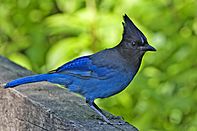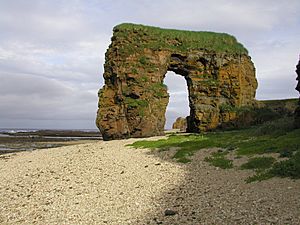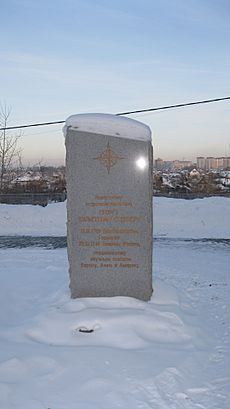Georg Wilhelm Steller facts for kids
- Top: Steller's sea eagle · Steller's jay
- Middle: Steller's eider · Steller sea lion
- Bottom: Steller's sea cow (extinct; sketch by J. F. Brandt)
Georg Wilhelm Steller (born March 10, 1709 – died November 14, 1746) was a German scientist. He was a botanist (someone who studies plants), a zoologist (someone who studies animals), a physician (a doctor), and an explorer. Steller worked in Russia and is known for being a pioneer in studying the natural history of Alaska.
Contents
Georg Steller's Early Life and Journey to Russia
Georg Steller was born in Windsheim, a town near Nuremberg in Germany. His father, Johann Jakob Stöhler, was a church singer. Steller studied at the University of Wittenberg. After his studies, he traveled to Russia in November 1734. He went there as a doctor on a ship carrying injured soldiers.
Joining the Great Northern Expedition
In Russia, Steller met a naturalist named Daniel Gottlieb Messerschmidt. After Messerschmidt passed away, Steller married his widow. He also gained access to Messerschmidt's notes from his travels in Siberia.
Steller learned about Vitus Bering's Second Kamchatka Expedition. This big journey had started in February 1733 from Saint Petersburg. Steller wanted to join, and he was accepted. In January 1738, he left Saint Petersburg. His wife stayed in Moscow. Steller met another scientist, Johann Georg Gmelin, in January 1739. Gmelin suggested that Steller take his place in the planned exploration of Kamchatka. Steller agreed and finally reached Okhotsk in March 1740. This was where Bering's ships, the St. Peter and St. Paul, were almost ready to sail.
Exploring Kamchatka and Alaska
In September 1740, the expedition sailed to the Kamchatka Peninsula. Bering's ships sailed around the southern tip of the peninsula to Avacha Bay. Steller went ashore on the east coast of Kamchatka. He spent the winter in Bolsherechye, helping to set up a local school and exploring the area.
First Steps in Alaska
Bering then asked Steller to join the voyage to find America and the strait between the two continents. Steller traveled across the peninsula by dog sled to join the ship as the expedition's scientist and doctor. During a storm, Bering's ship, the St. Peter, got separated from the St. Paul. Bering wanted to keep sailing east, hoping to find land soon. Steller, however, studied the ocean currents, floating objects (called flotsam), and wildlife. He believed they should sail northeast instead. After some time, they finally turned northeast.
On Monday, July 20, 1741, they reached land in Alaska at Kayak Island. Bering only wanted to stay long enough to get fresh water. Steller convinced him to give him more time to explore the land. He was given 10 hours.
During his ten hours on land, Steller was one of the first non-native people to step onto Alaskan soil. He was the first European naturalist to describe many North American plants and animals. One of these was a bird later named Steller's jay.
Discoveries and Extinct Animals
Of the six types of birds and mammals Steller discovered on this trip, two are now extinct. These are Steller's sea cow and the spectacled cormorant. Three others are endangered or have very small populations: the Steller sea lion, Steller's eider, and Steller's sea eagle.
The Steller's sea cow was a huge animal, related to the dugong. It became extinct only 27 years after Steller discovered it. This was because Russian sailors who came after Bering hunted them too much.
Steller's jay is one of the few species named after Steller that is not currently endangered. When Steller saw this bird, he realized it was related to the American blue jay. This helped prove that Alaska was indeed part of North America.
Shipwreck and Survival
On the return journey, many crew members became sick with scurvy. Steller tried to treat them with leaves and berries he had found. However, the officers did not listen to his advice. Steller and his assistant were among the few who did not get sick.
The ship was in bad shape, and the expedition was shipwrecked on what is now known as Bering Island. Almost half of the crew had died from scurvy during the voyage. Steller cared for the survivors, including Bering, but the captain passed away.
The remaining men set up camp with little food or water. Arctic foxes often raided their camp. To survive the winter, they hunted sea otters, sea lions, fur seals, and sea cows. Even with all these difficulties, Steller studied the island's plants, animals, and landscape in great detail. He made important observations of Steller's sea cow. This large mammal, similar to a manatee, used to live across the Northern Pacific. However, by Steller's time, only a small group remained around the Commander Islands. It was hunted to extinction within 30 years of its discovery by Europeans.
Steller later wrote a book called De Bestiis Marinis (which means 'On the Beasts of the Sea'). In this book, he described the animals of the island. These included the northern fur seal, the sea otter, Steller sea lion, Steller's sea cow, Steller's eider, and the spectacled cormorant. Steller also claimed to have seen a mysterious sea creature he called Steller's sea ape.
Later Life and Legacy
In early 1742, the crew used parts from the wrecked St. Peter to build a new ship. They called it The Bering. Steller spent the next two years exploring the Kamchatka peninsula.
Because he showed kindness and support for the native Kamchatkan people, he was accused of causing trouble. He was called back to Saint Petersburg. At one point, he was held and had to return to Irkutsk for questioning. He was later set free and started his journey back to Saint Petersburg. However, he became ill with a fever and died in Tyumen at the age of 37.
Steller's journals were sent to the Academy of Sciences and later published. Other explorers of the North Pacific, like Captain Cook, used his detailed notes.
Animals and Plants Named After Georg Steller
Georg Steller described many animals and plants. Some of them are named after him, either in their common name or scientific name:
- Steller's eider (Polysticta stelleri)
- Steller's jay (Cyanocitta stelleri)
- Sea otter (Enhydra lutris)
- Steller's sea eagle (Haliaeetus pelagicus)
- Short-tailed albatross
- Steller's sea cow (Hydrodamalis gigas)
- Steller sea lion (Eumetopias jubatus)
- Steller's sculpin
- Gumboot chiton (Cryptochiton stelleri)
- Hoary mugwort (Artemisia stelleriana)
- Stellera L. (Thymelaeaceae)
- Stellerite (a mineral)
- Restella Pobed. (Thymelaeaceae)
Steller Secondary School in Anchorage, Alaska is also named after him.
See also
 In Spanish: Georg Steller para niños
In Spanish: Georg Steller para niños









